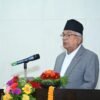Kathmandu, Nov 5: French photographer and filmmaker Eric Valli is best known for capturing the lives of Himalayan communities in Nepal and their deep connection with nature. Born in France in 1952, Valli has been working extensively in South Asia, especially Nepal, since the 1980s.
In 1999, he directed the internationally acclaimed film ‘Caravan: Himalaya’ which vividly portrayed the hardships, traditions, and spirit of life in the high mountains. The film went on to receive an Oscar nomination, earning global recognition for its stunning cinematography and deep storytelling.
Before that, he had already given his some masterpieces (acclaimed documentaries) such as Honey Hunters, Nepal: Beyond the Clouds, and Himalayan Gold Rush, all of which profoundly explored the lives and environments of Nepal’s mountain regions. His photographs have been featured in leading international publications including National Geographic, Geo Magazine, and others.
His works reveal a deep emotional connection with Nepal. A man who holds great affection for the country’s mountain life, natural beauty, and local traditions, Valli considers Nepal his second home.
In recent years, he has developed a keen interest in the Chhath festival, which is celebrated especially in the Terai region in honor of the Sun. To him, it is one of Nepal’s most special and meaningful festivals. He is open to say that he is continually moved by the country’s rich cultural values and the simplicity of its people’s lifestyle.
Lately, Valli has been actively involved in environmental conservation, promotion of rural tourism, and community development initiatives.
He recently visited the Rastriya Samachar Samiti (RSS) central office in Bhadrakali, Kathmandu, where he spoke with RSS journalists Bhisma Raj Ojha and Srijana Rai. The following are excerpts from his interview with them.
You have been closely connected with Nepali culture, society and lifestyle for a long time. How and where did your relationship with Nepal begin? What is it that has kept you connected to the country for all those years?
Nepal was love at first sight for me. In one word: love. I first came to Nepal in 1973, traveling via Banaras Road. I hiked part of the way and even rode on the roof of a large Tata truck. I can hardly forget my first moments stepping into this beautiful country.
The mesmerizing beauty of its landscape, the neatly constructed red and white- painted houses standing in quiet harmony, and the mountains rising behind them like ancient sentinels, made my heart race. Almost fifty years ago, the landscape and lifestyle I saw here, a symphony of colors and culture, made Nepal my love at first sight.
The mesmerizing beauty of its landscape, the neat and beautifully daubed red and white houses, and the breathtaking view of the mountains behind them made my heart race. Almost fifty years ago, the landscape and lifestyle I saw here made Nepal my love at first sight.
I am French, and my home country is beautiful too. Yet my first visit to Nepal, after years of routine and monotony in France, left me simply speechless. Every step of my journey here, even along the most challenging or unusual paths, felt like an invitation to marvel at the world. Upon arriving, Nepal’s culture revealed itself as a treasure trove of discovery, each tradition and custom sparkling with wonder. My love for this country has only deepened with time. Now, at 73, looking back, I find that everything here continues to enchant and captivate me.
How do you remember your first encounter with Dolpo, its communities, and culture, where your film Caravan was shot?
Dolpo was like another beautiful love story for me. I first visited the area around 1981, at a time when the government had not officially permitted foreigners to enter Dolpo which was almost a forbidden land. The moment I set foot there, I was struck by an unforgettable cultural shock: the region, still largely untouched by outsiders, seemed frozen in time. That fascinated me. One of the reasons I fell in love with Nepal was its unique culture in Dolpo.
I stayed for a long time at the home of my friend Thinley, the main character of Caravan: Himalaya. He was my guide through Dolpo who was by my side in my journey to feel the land, its culture, lifestyle and struggle. With the respect of his proposal, I made that film.
I had shown him some of my films and he proposed an idea to make a film revolving around the culture, lifestyle and hardship of Dolpo. We started making the film following an in-depth study of Dolpo.
The people of Dolpo lived in close harmony with nature. They built their homes from stone and wore garments they had woven themselves. Life in this beautiful region was hard, yet its inhabitants were brave, resilient, and hardworking. Truly, Nepal is a land enriched with culture, language, traditions, and natural beauty.
Every new place I visit in Nepal feels like a world full of lessons waiting to be discovered. Nepal has always been a hub of endless research and exploration, and studying Dolpo was especially captivating. During my filmmaking there, I didn’t just form professional connections I also made lasting friendships, many of which continue to this day.
Let me share a small story. During my travels in Dolpo, my shoes tore. I asked a local cobbler to make a new pair from yak leather. The conversation about size and payment still makes me smile. He said, “I’ve never made shoes this big, but I can do it.” When I asked about the cost, he replied, “Give me forty pathi of flour (one pathi is around 3.3 kilos).” I didn’t have any flour, so I offered money instead. He shook his head: “Money won’t work, give me flour.” Only after buying and giving him the flour did he make the shoes. Those were different times.
I fell deeply in love with the old Dolpo. Life there was challenging, medical help was scarce, and daily life was far from easy. Yet the people were not only brave; they lived with a strong sense of dignity, pride, and self-respect.
What differences have you seen in Dolpo fifty years ago and now?
Many things have vanished in Dolpo over the past fifty years. Dolpa has changed after roads reached it. There is a significant difference between the Dolpo I knew fifty years ago and the present Dolpo.
Dolpo looked dry then and flat-roofed houses could be seen. May be due to global climate change, rainfall has started occurring now. The endangered, original and fascinating physical structures and architecture are no longer in use. It seems like the effect of climate change.
Recently, with the increase in Nepali youths going abroad, I have seen its impact in Dolpo as well. The villages are deserted. Only the elderly remain in the villages. While there are effects of climate change, I have seen youth migration in search of employment as the major problem.
How will Nepal develop when its energetic youth workforce has gone abroad! The government needs to seriously consider this.
As a foreign director, how easy was it for you to responsibly present Nepali culture in your film?
I am a carpenter by profession and film was my interest. As a foreign director, I had to put in little more efforts here. I am honest not only to my work but also to the culture and community here. Love for this country and culture helped me in making the film.
If we were to make a film, we need to know about the subject matter. Thorough study is necessary before shooting a film. A good script must be written. We had even studied for three years just to write a script about the Himalayas and the caravan. Deeper study increases understanding of your story and characters and this naturally opens up the path.
I still remember what my friend Thinley said, “Our culture is also melting like the snow,” and to this I replied, “My culture is also fading in France.” Now, the globalisation is changing everything. Every culture has such features that need to be preserved and documented. Whether by writing books or making films, they must be preserved.
While writing the story of Dolpo, that film became the last caravan in the world. It was truly a great responsibility. There were many challenges and complexities.
What are your suggestions for taking Nepalese films directed by Nepalese directors to the global community? What should new directors pay attention to?
While writing the script for Himalayan Caravan, I was fully aware of the need to reflect Nepali culture. But I was equally conscious of how to make it global and reach an international audience. I had to bring out the ‘universal’ story. If we only show the culture, it is limited to an audience that understands it. The story of Caravan is based on an intergenerational conflict and struggle between an old man and a young man. Therefore, the film depicts a struggle between two generations for leadership, which is something that all audiences around the world can understand and be drawn to.
Making Caravan was not possible with a little effort. Selecting the cast from the community was also an important task. Jack Perrin is an excellent producer. It took nearly three years to prepare the script for this. Yes, to bring a local story to an international audience, the story must become ‘universal’ along with the need for a strong team.
No one would have imagined that Caravan would become so successful. I myself did not know it would reach the Oscars. I worked hard, and the hard work took me that far. We cannot claim that a film made with sufficient investment and time will be successful. ‘Honey Hunters’ was also one of the most liked stories on National Geographic because it was not only a Nepali story but a universal story.
How do you think your film has influenced the global perspective towards Nepal and Nepali culture? Do you have any suggestions to promote tourism development?
I understand that my films have certainly succeeded in drawing the world’s attention to Nepal. And I feel that interest in Nepal’s tourism, culture, and conservation efforts has also begun to increase. Nepal needs as much promotion and publicity as possible to become a tourist destination.
I also worked to promote and spread Nepali culture to the world community. To promote it, one has to work with those who have international connections, which is quite expensive. While making Nepali films, I did not receive any possible support from the Nepal government for its promotion.
‘Caravan: Himalayan’ film reached the Oscars. Honey Hunters was featured on the cover of National Geographic. Despite my love, goodwill and good deeds for the country, I have repeatedly faced problems obtaining a visa from the Nepalese government. I have had a lot of trouble getting a visa. Yet, I feel love for Nepalese people. I feel love for Nepal. I believe my work will always have a positive impact on Nepal and the Nepalese.





